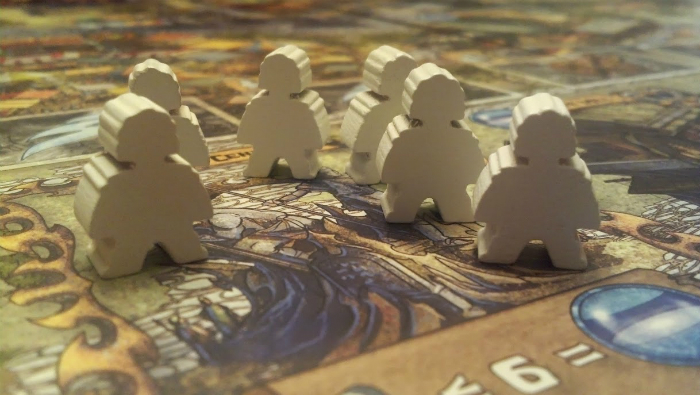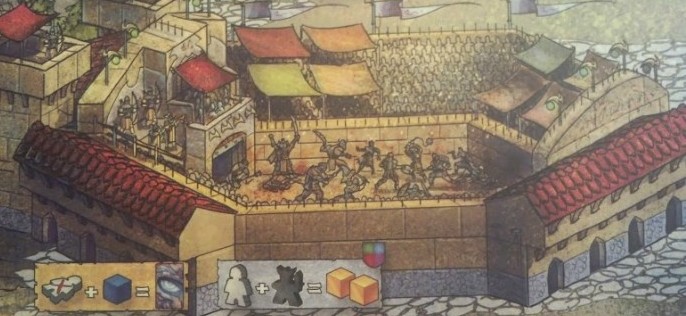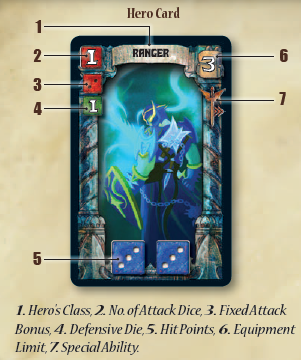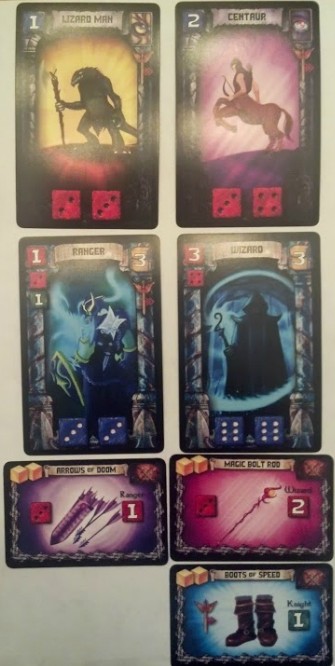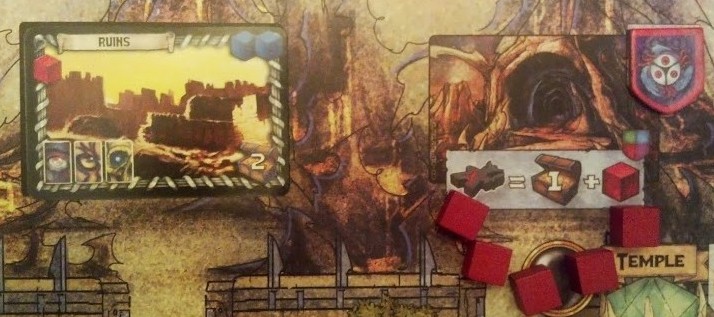Journal of Arnton Fennif, Royal Surveyor
Field Notes, Day 3:
As we continued our expedition through the former city of Karez, we were surprised to discover that it was not entirely uninhabited, as was previously thought. While much of the ruins remain to be explored, several sections have been marked as outwardly hostile to others. We lost two sentries before abandoning the last encampment for something a bit closer to old city center. We will have to be more cautious…
Field Notes, Day 7:
More surprises! Apparently a daring band of citizens have taken up residence in a relatively safe zone on the southern side of the ruins. Their existence is meager, but they have made progress towards a sustainable life here. Many appeared to welcome the King’s desire to restore the city’s glory. I will dispatch a rider tomorrow to the court to inform him that it appears Karez is indeed alive, and to send aid.
The Premise
Players are powerful lords of different factions within the kingdom of King Tyrial II. The great city of his father, Karez, was reduced to ruins after he died. Players have been sent to the city to clear away its enemies and restore Karez to its former glory. However, only one faction will get to rule when all is set and done.
The Rules:
Fallen City of Karez is a large worker-placement game, and setup requires some table space. Additionally, the game has a lot of moving parts, so you will want to consult the rule book for full explanation.
To start, place all of the various decks and resources near the board. Each player is given a guild that they will portray, either by choice or randomly. Each guild comes with a special ability to earn Victory Points, as well as starting guild tokens, Gold, Heroes, Encounter (monster) cards, and ownership of a specific building in the city. Lastly, the Adventure deck (representing various dungeons) is set, the initial crew of meeple workers is placed, and the first Visitor card (a variable action to take), is turned up.
The game is played over a series of eight rounds, each with five phases: Action, Activating, Adventure, State of Karez, and Replenishing. Players go in turn order (initially by printed guild order and later by Valor tokens) through each phase.
The Action phase is the action-taking and worker placement step of the game. These actions take place at various locations around Karez. Only some buildings are available for use at the beginning of the game; others come online as the size of the city progresses from Village to Town to City. Players place guild tokens to do one of the following:
- Purchase an unowned (and available) building.
- Reserve an action at a building not owned by themselves by moving the required available workers (white Citizens or black Adventurers) to that action space.
- Send Heroes to a dungeon.
- Open / Close a Private Dungeon.
Additionally, players can use their turn to reserve actions at buildings they do own, or they can purchase Items & Instants.
Purchasing and operating a private dungeon are resolved immediately. The rest, unlike most worker-placement games, do not. Once all players finish their actions, play proceeds to the Activating phase. It is here that worker activation spaces are resolved. Workers are returned to the worker pool on the board unless they are killed by the action. Players also get a second chance at purchasing Items & Instants. This continues until everything is resolved.
In the Adventure phase, players determine the outcome of their journeys into various dungeons. Combat ensues between a player’s Heroes and the dungeon’s monsters until the player wins, the Heroes die, or the Heroes flee.
Next, the State of Karez phase checks to see the current Valor vs. Threat level of the city, which determines the number and types of new workers coming into the city, as well whether the city grows – or shrinks – to its next state. Lastly, the Replenishing phase resets the board, advances the round, addresses the dungeon statuses and Visitors, and sets up the new turn order.
At the end of the 8th round, the game ends. If Karez is not a city by this point, everyone loses. If it is, the player with the highest VP is declared the new Lord of Karez.
Everyone else gets fed to the dragon.
Getting Out The Red Pen
Karez’s major selling point is that it’s a large fantasy-based worker placement game. It certainly looks the part: the game board and card art is fantastic (although just a tad busy), and the distinctive meeple workers really evokes the flavor of a city battling back from extinction.
From a thematic standpoint, it hits all the buttons Immersionists like to see.
But let’s get one fundamental issue out of the way right off the bat: this is not a semi-cooperative game, no matter how much it is billed as such. It’s quasi-cooperative at best. In fact, there is only one pivotal rule that forces the guilds to work with one another at all: if the board does not reach City status by the end of the game, everyone loses. This is an important distinction, because if you go in to the game willing to aid one another without much compensation (the do-gooder that you are), the game won’t make much sense mechanically. If it was more of a semi-cooperative rather than marriage of convenience, for example, you may find yourself helping restock the Marketplace if you’re not the Trade Guild because you want more items and are willing to use your own actions to do it.
Four of the five guilds are neutral to one another by default, but the Arcane Guild indirectly works against the rest of the players to achieve its own victory. It has to pull a punch here and there to guarantee they too don’t lose, but this act alone does not a co-op make, semi or otherwise.
It’s that sort of confusion of a player’s motivation that gets Karez into trouble, and it unfortunately is not the only trip-up. Its execution overall is decisively mixed.
Omission Impossible
Games live and die by how easily players can follow what is being asked of them. The more complex your game gets, the more information you’re asking players to retain in order to fulfill the objective. Entire subsets of gamers don’t even bother with games once they reach a certain complexity threshold (looking at you, Socializers). It is imperative, then, to make sure your rules are laid out in a comprehensive and understandable manner. Trying to remember nuanced rules is hard enough without players having to decipher the context of those rules as well.
Writing rules to a complicated game is not easy. Really. Try it sometime; you’ll be surprised that it’s more difficult than it appears.
It’s not uncommon for bigger games to take a reputation hit because the rule book isn’t as clear or concise as we gamers would like it to be. Karez is no different: the rule book is the game’s largest detraction.
At a mere 16 pages for a game of its size, it does get the basics across decently enough. In several areas it displays most card functions and game setup / replenishment using handy breakdowns and pictures.
Yet only three pages are spent on how worker placement behaves with all of the different buildings in the game, and few of those descriptions are very elaborate.
After playing, it feels like there are parts of the rules missing, as there are clarifications that need to be inferred or are omitted entirely. The sense is that the rules were written by those who already knew how the game works, but they neglected to include some bits, assuming that everyone would make the same logical assumptions that they did. What’s more, many of the important rules clarifications that are included are italicized and can be easily overlooked.
It’s evident by an FAQ at the end that the creators were aware of possible confusion, but the FAQ simply doesn’t go far enough. This could be rectified with future rulebook updates and/or a more comprehensive FAQ section. In the meantime, we suggest you add extra “clarification time” for your first play-through or two, and seek out supplementary information from external sites like BoardGameGeek.
Baby Needs A Pair of Threes
One area the rules excel at are the pages spent in detail explaining how the dungeon combat system works. The issue with combat isn’t one of comprehension though, but of game flow.
Players don’t enter dungeons to fight every round, but doing so changes the tempo of the game. Whereas in the Action/Activating phases where all players are taking turns, Adventuring is a solo sport. Players not involved in the dice rolling are effectively sidelined from the game until the player succeeds or dies. In isolation, this would be minor.
However, combat itself is based around a hit/miss system of matching dice results with one another. In the early rounds of outfitting your Heroes, you could spend several minutes just trying to roll that ‘4’ you need to beat that pesky Minotaur in your way.
The opposite happens in later rounds when your party members are decked out in armor and gear that provides additional rolls, fixed hits, and/or dice manipulation. Here, the dice rolls almost feel inconsequential. Normally, the idea of slaying random monsters would be enticing to Strikers, but chances are they’ll find it too swingy and random for their liking, as the dice control more of the outcome than they do.
It’s not a commonly seen combat mechanic, and it is exciting at first. The initiative bit is particularly well-done. Just don’t be surprised if your opinion shifts from admiration to admonishment if it bogs the game down though.
Private Dungeons Available, Slightly Occupied
Unless you are the Arcane Guild whose victory rests on generating Threat through their catacombs, having your own private dungeon is largely a waste of resources. It’s a heavy investment to secure and stock a dungeon with baddies for that massive 1VP it’s worth at the end of the game, and most players looking to dungeon dive are likely to tackle one of the neutral places instead. If you have a lot of extra money, you could always attack your own dungeon for some Valor and treasure, but it doesn’t make a lot of sense to do so thematically. Granted, that won’t stop Tacticians from enjoy testing different winning strategies, and they’ll do it if it lets them scheme towards the Lordship.
The idea for a private dungeon is as enticing as it sounds, but the implementation is weaker than it could be. Considering assembling your own cadre of Heroes and dungeon monsters is the only avenue for Architects to amass their own stuff, it’s probably wise they opt out of helping to restore Karez.
Guild Member For Life
You really do get a feeling that each guild has their own motivations for rebuilding Karez. The thing is, these roles are predefined, and therefore, so is your objective. Many games award players at the start with a specialized skill or ability that they may or may not take advantage of throughout the game. That choice is left up to the player. However, unlike those games, Karez’s roles ostensibly determine how you are going to play the game. It is very difficult to win if one player is working towards their guild’s VP condition and you aren’t because you’d prefer to try another guild’s tactics instead. Daredevils, this is not your game. You are forced into the position the guild demands, so it’s a relief that the rules at least allow players to choose their guild. This would be minor, again, if not for the fact that the guilds aren’t on equal footing.
The simple truth is that some guilds are inherently easier to play (and win) with. The Arcane Guild needs to work against the other players for Threat, the Heroic Guild needs to swashbuckle their way through dungeons for hard-fought Valor, and the Builder Guild needs to . . . sit there and buy up buildings?
We’re certain that the more experienced players become with Karez, this disparity evens out, but intentionally or not, prior experience with the game shouldn’t be a requirement to ensuring mechanical balance.
The Takeaway
Fallen City of Karez very much looks the part of a worker-placement game set in a fantasy world. The creators desired a game that allows a city-building aspect on the one side with adventure-themed exploration on the other. The detailed artwork and dungeon-diving components are testaments to this ambitious task; you can tell a lot of effort went into the creation of Karez. While it hits a number of the lofty goals it aimed for, unfortunately it also comes with some baggage.
The largest stumbles are rules clarity and some parity issues with guild functionality. Such things could be corrected with future PDF rule editions, as all of the components are already present to make Karez the great game it strives to be. As it exists though, it misses the high bars and instead lands on the middle rung of games that are enticing enough to play, but have reasons to keep you from wanting to come back.
Cardboard Republic Snapshot Scoring (Based on scale of 5):
Artwork: 4.5
Rules Clarity: 2.5
Replay Value: 2
Physical Quality 4
Overall Score: 2.5

